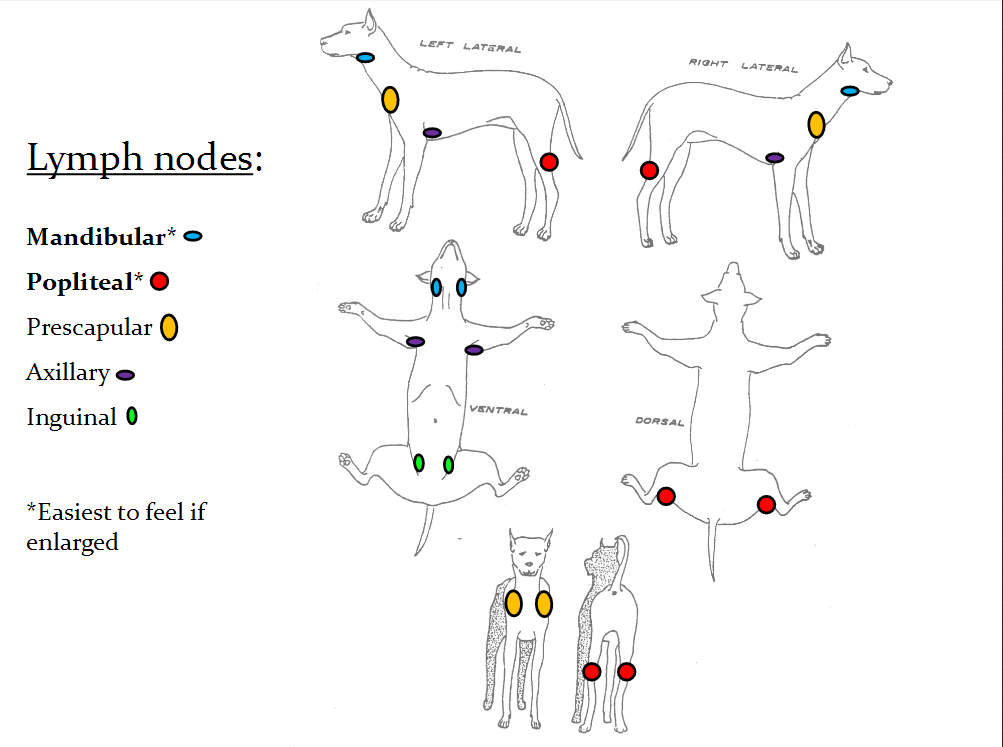| Lymphoma describes a diverse group of cancers in dogs that are derived from white blood cells call lymphocytes. Lymphocytes normally function as part of the immune system to protect the body from infection. It most commonly arises in organs that function as part of the immune system such as the lymph nodes, spleen and bone marrow. The most common type of lymphoma in dogs is multicentric lymphoma, in which the caner first becomes apparent in the lymph nodes. |
Other common lymphomas in dogs include cutaneous lymphoma (lymphoma of the skin), alimentary or gastrointestinal lymphoma (lymphoma of the stomach and/or intestines) and mediastinal lymphoma (lymphoma involving organs within the chest, such as lymph nodes or the thymus gland).
Lymphomas represent approximately 7-14% of all cancers diagnosed in dogs. Some progress rapidly and are acutely life threatening without treatment, while others progress very slowly and are managed as chronic, lethargic diseases.
Canine lymphomas are similar in many ways to the non-Hodgkin’s lymphomas (NHL) which occur in humans. Canine lymphomas and NHL are nearly indistinguishable when examined microscopically and both tumor types exhibit similar responses to chemotherapy.
Lymphomas represent approximately 7-14% of all cancers diagnosed in dogs. Some progress rapidly and are acutely life threatening without treatment, while others progress very slowly and are managed as chronic, lethargic diseases.
Canine lymphomas are similar in many ways to the non-Hodgkin’s lymphomas (NHL) which occur in humans. Canine lymphomas and NHL are nearly indistinguishable when examined microscopically and both tumor types exhibit similar responses to chemotherapy.
Common symptoms of canine lymphoma
| The most common initial symptom of multicentric lymphoma in dogs is firm, enlarged, non-painful lymph nodes. A lymph node affected by lymphoma will feel like a hard, rubbery lump under your dog’s skin. Other common symptoms include loss of appetite, lethargy, weight loss, swelling of the faces or legs (edema) and occasionally increased thirst and urination. Cutaneous lymphoma tends to appear first as dry, flaky, red and itchy patches of skin anywhere on the body. As it progresses, the skin becomes moist, ulcerated, very red and thickened. Masses in the skin can also occur with cutaneous lymphoma. It may also appear in the mouth, often affecting the gums, lips and the roof of the mouth. |
Gastrointestinal lymphoma presents with vomiting, watery diarrhea and weight loss. The diarrhea is often very dark in color and foul smelling.
Dogs with mediastinal lymphoma typically have difficulty breathing. This may be due to the presence of a large mass within the chest or due to the accumulation of fluid with the chest (pleural effusion). Affected dogs may also show swelling of the face or front legs as well as increased thirst and urination.
Dogs with mediastinal lymphoma typically have difficulty breathing. This may be due to the presence of a large mass within the chest or due to the accumulation of fluid with the chest (pleural effusion). Affected dogs may also show swelling of the face or front legs as well as increased thirst and urination.
How is canine lymphoma diagnosed?
The best way to diagnose lymphoma is to perform a biopsy to remove a piece of the lymph node or other affected organ. The most common methods for lymph node biopsy as Tru-cut needle biopsy, incisional wedge biopsy, or removal of the entire lymph node (excisional biopsy). The larger the biopsy sample, the better the chance for an accurate diagnosis of lymphoma.
In addition of biopsy, blood tests, a urinalysis, x-rays, an abdominal sonogram and a bone marrow aspirate are used to determine how far the lymphoma has spread throughout the dog’s body.
In addition of biopsy, blood tests, a urinalysis, x-rays, an abdominal sonogram and a bone marrow aspirate are used to determine how far the lymphoma has spread throughout the dog’s body.
How is canine lymphoma treated?
The most effective therapy for most types of canine lymphoma is chemotherapy. Surgery or radiation therapy may also be recommended in some cases. Most dogs with lymphoma experience remission of their cancer following treatment and side effects are usually not severe. Remission means a regression of a dog’s cancer. Remission may be partial, meaning the overall cancer load has been reduced by at least 50% or it may be complete, meaning the cancer has become undetectable to any readily available screening test.
Most dogs tolerate chemotherapy well, actually must better than humans typically do. Generally, fewer than 5% of dogs treated for lymphoma using chemotherapy will experience side effects that need to be managed in a hospital setting. The most common side effects include loss of appetite, decreased activity level and mild vomiting or diarrhea that persists for a day or two.
Unlike people, dogs usually do not lose their hair when treated with chemotherapy. The exceptions to the rule are Poodles, Old English Sheepdogs and some Terriers.
Most dogs tolerate chemotherapy well, actually must better than humans typically do. Generally, fewer than 5% of dogs treated for lymphoma using chemotherapy will experience side effects that need to be managed in a hospital setting. The most common side effects include loss of appetite, decreased activity level and mild vomiting or diarrhea that persists for a day or two.
Unlike people, dogs usually do not lose their hair when treated with chemotherapy. The exceptions to the rule are Poodles, Old English Sheepdogs and some Terriers.
How is chemotherapy given?
Where can your dog receive chemotherapy?
Dr. Rogers Fred III and his wife Kim, run Valley Veterinary Oncology, P.C. (VVO), an independent specialty practice located within the Valley Veterinary Emergency and Referral Center offering consultation services, cytology interpretation (in house and referral) and chemotherapy. They provide compassionate individualized cancer care for their patients and their owners.



 RSS Feed
RSS Feed